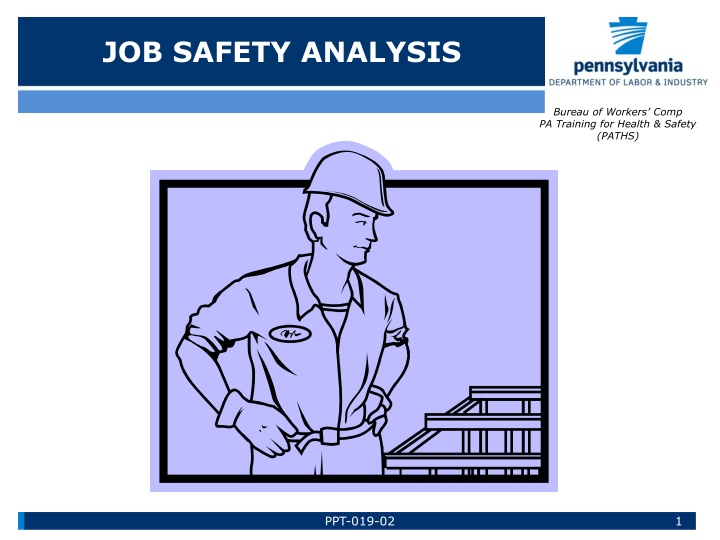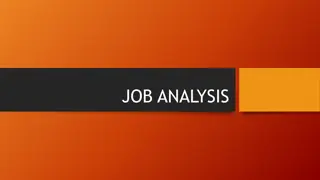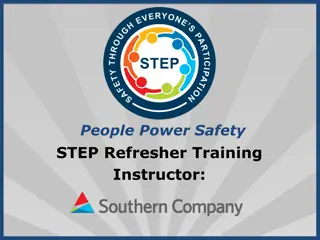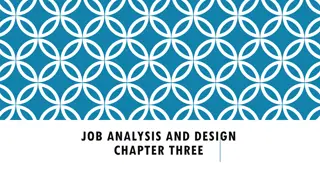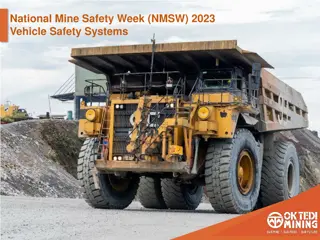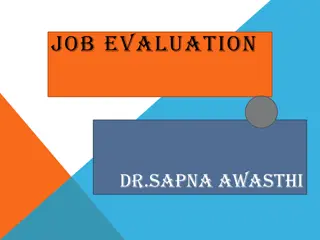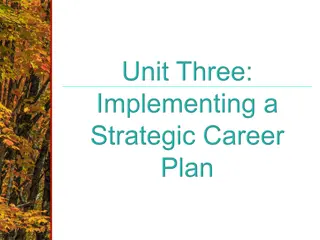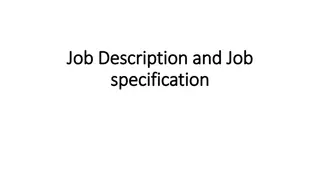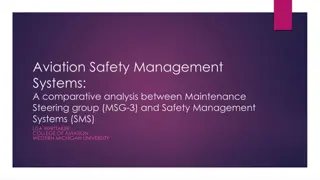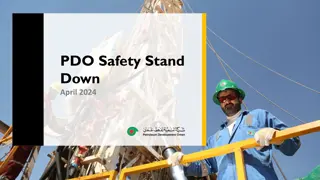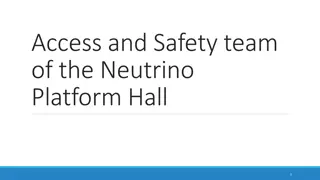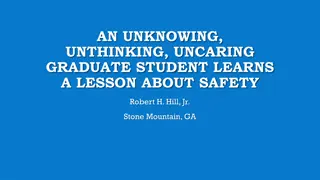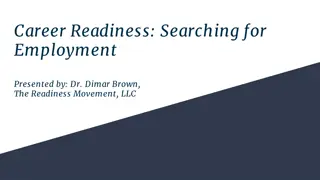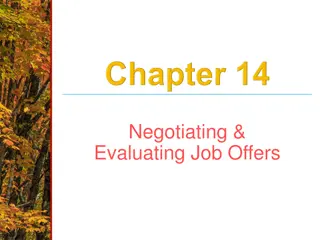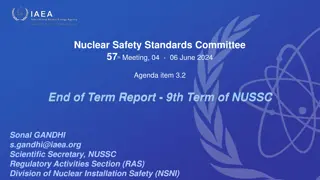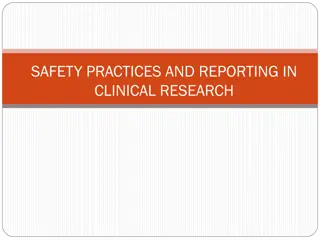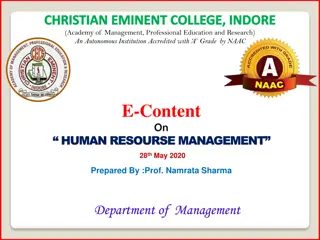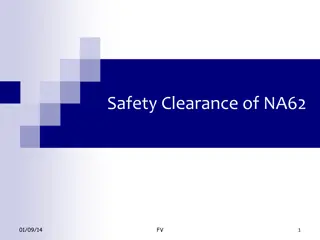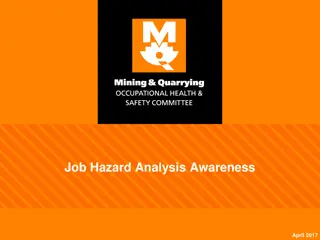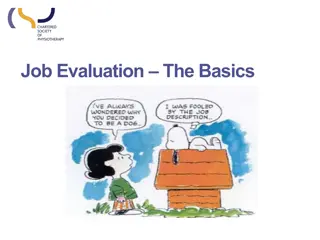Job Safety Analysis
Job Safety Analysis (JSA) is an essential process for identifying hazards and ensuring safe work procedures. It involves breaking down tasks into key steps to assess risks and safety requirements. Prioritizing new jobs, severity potential, history of injuries, and accident frequency are crucial factors. Too detailed or too general analysis can be ineffective, so finding the right balance is vital for creating a successful JSA. Examples like changing a flat tire demonstrate the importance of clear and concise key steps to prevent workplace accidents.
Download Presentation

Please find below an Image/Link to download the presentation.
The content on the website is provided AS IS for your information and personal use only. It may not be sold, licensed, or shared on other websites without obtaining consent from the author.If you encounter any issues during the download, it is possible that the publisher has removed the file from their server.
You are allowed to download the files provided on this website for personal or commercial use, subject to the condition that they are used lawfully. All files are the property of their respective owners.
The content on the website is provided AS IS for your information and personal use only. It may not be sold, licensed, or shared on other websites without obtaining consent from the author.
E N D
Presentation Transcript
JOB SAFETY ANALYSIS Bureau of Workers Comp PA Training for Health & Safety (PATHS) PPT-019-02 1
Job Safety Analysis Also known as job hazard analysis, job safety analysis is: The breaking down into its component parts of any method or procedure to determine the hazards connected with each key step and the requirements for performing it safely. PPT-019-02 2
Job Safety Analysis Priorities New jobs Severity potential History of disabling injuries Frequency of accidents PPT-019-02 3
Job Safety Analysis Job means task, for example: changing a tire, not being an auto mechanic When creating a job safety analysis, it s important to use clear, key steps. Too detailed becomes cumbersome Not enough detail becomes useless PPT-019-02 4
Break Job Down into Key Steps AVOID: Making job breakdown so detailed that it results in a large number of steps. Making breakdown so general that basic steps are not recorded. PPT-019-02 5
Changing a Flat Tire on an Automobile Job Safety Analysis PPT-019-02 6
Changing a Flat Tire Key Steps (TOO MANY) 7. Walk to trunk 8. Put key in lock 9. Open trunk 10.Remove jack 11.Remove Spare tire 1. Pull off road 2. Put car in park 3. Set brake 4. Turn on four ways 5. Open door 6. Get out of car PPT-019-02 7
Changing a Flat Tire Key Steps (NOT ENOUGH) 1. Park car 3. Put on spare tire 2. Take off flat tire 4. Drive away Buckeye Towing PPT-019-02 8
Changing a Flat Tire Key Steps (JUST RIGHT) 1. Park car, set brake 2. Remove jack and tire from trunk 3. Loosen lug nuts 4. Jack up car 5. Remove tire 6. Set new tire 7. Jack down car 8. Tighten lug nuts 9. Store tire and jack PPT-019-02 9
Hazards Jacking up car Car could fall off jack Setting new tire Fingers pinched Back strain Tighten nuts Back strain Slip and fall Parking car Struck by traffic Removing tire and jack Back strain Strike head on trunk Loosen lug nuts Back/arm strain Slip and fall PPT-019-02 10
Work Observation Select experienced worker(s) who will cooperate and participate in the JSA process. Explain purpose of JSA. Observe the employee performing the job and write down basic steps. Completely describe each step. Note deviations (very important!). PPT-019-02 11
Identify Hazards and Potential Accidents Search for Hazards Produced by work Produced by environment Repeat job observation as many times as necessary to identify all hazards. PPT-019-02 12
Develop Solutions Find a new way to do job. Change physical conditions that create hazards. Change the work procedure. Reduce frequency. PPT-019-02 13
New Way to do Job Determine the work goal of the job, and then analyze the various ways of reaching this goal to see which way is safest. Consider work-saving tools and equipment. PPT-019-02 14
Change in Physical Conditions Tools, materials, equipment layout or location. Study change carefully for other benefits (costs, time savings). PPT-019-02 15
Change in Work Procedures What should the worker do to eliminate the hazard? How should it be done? Document changes in detail. PPT-019-02 16
Reduce Frequency What can be done to reduce the frequency of the job? Identify parts that cause frequent repairs/ change. Reduce vibration, save machine parts. PPT-019-02 17
What Effects? A job that has been redesigned may affect other jobs or work processes. Check or re-observe the new process once it has been redesigned. PPT-019-02 18
Summary JSA/JHAs Get assistance from employees who are knowledgeable of and actually do job/task. Break job/task down into simplified steps. Too many or not enough steps = not useful. Look at all hazards/issues and plan for adequate protection. Goal: protect employees from injuries. PPT-019-02 19
Questions PPT-019-02 20
